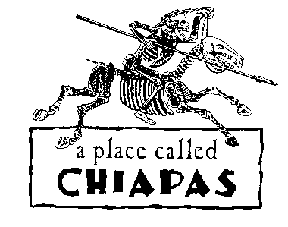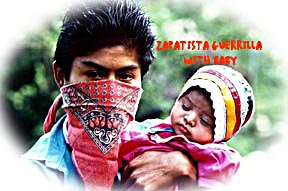|
________________
CM . . . .
Volume VII Number 10 . . . . January 19, 2001
The filming is exceptional, and the scenery of rural Mexico is at once breathtakingly beautiful and
amazing in its squalor and poverty. The interviews with people from all walks of life are
interesting, but the major drawback for classroom use is that much of the video employs the use
of subtitles to translate what the indigenous peoples and the Spanish speakers are saying. This is
not always the most user-friendly method for students in a classroom, and, for that purpose, a
translator may have been a better choice. The occasional vulgarity may also be a problem in some
schools.
The detail presented brings the violence in Chiapas into focus, but it is also a drawback for
classroom use. Judicious use of "in-house" editing will help those classroom teachers who wish to
present this material to their students, but who cannot give 93 minutes to the endeavor. The
video would be useful for any classes studying the country of Mexico, the effects of the NAFTA,
or revolutionary movements.
Recommended.
Katie Cook is a social studies teacher and a teacher-librarian at the Steinbach Regional Secondary
School in Steinbach, MB.
To comment on this title or this review, send mail to cm@umanitoba.ca.
Copyright © the Manitoba Library Association.
Reproduction for personal use is permitted only if this copyright notice
is maintained. Any other reproduction is prohibited without
permission.
Published by
TABLE OF CONTENTS FOR THIS ISSUE - January 19, 2001.
AUTHORS |
TITLES |
MEDIA REVIEWS |
PROFILES |
BACK ISSUES |
SEARCH |
ORDER |
CMARCHIVE |
HOME
|

 On January 1, 1994, the indigenous Zapatista National Liberation Army (EZLN) went to war
against the Mexico of President Zedillo because of the North American Free Trade Agreement.
Subcomandante Marcos is the leader of the Zapatistas. This video looks at the conflict that the
time of uneasy peace since that fighting has left behind, as villages are divided between
pro-government and pro-Zapatista supporters. The Roman Catholic Church is heavily involved in
attempting to bring reconciliation to the two sides, but violence is on-going as 30,000 government
troops have the rebels bottled up in the Locandon jungle in the Mexican province of Chiapas.
Interviews with Subcomandante Marcos and his supporters bring out their side of this fight.
People left refugees in their own country because the fighting leaves them unable to return to their
homes are given the chance to tell their stories, as are the government supporters who are
preventing them from returning to their land and homes. While both sides are represented, the
video is pro-Zapatista in its outlook.
On January 1, 1994, the indigenous Zapatista National Liberation Army (EZLN) went to war
against the Mexico of President Zedillo because of the North American Free Trade Agreement.
Subcomandante Marcos is the leader of the Zapatistas. This video looks at the conflict that the
time of uneasy peace since that fighting has left behind, as villages are divided between
pro-government and pro-Zapatista supporters. The Roman Catholic Church is heavily involved in
attempting to bring reconciliation to the two sides, but violence is on-going as 30,000 government
troops have the rebels bottled up in the Locandon jungle in the Mexican province of Chiapas.
Interviews with Subcomandante Marcos and his supporters bring out their side of this fight.
People left refugees in their own country because the fighting leaves them unable to return to their
homes are given the chance to tell their stories, as are the government supporters who are
preventing them from returning to their land and homes. While both sides are represented, the
video is pro-Zapatista in its outlook.